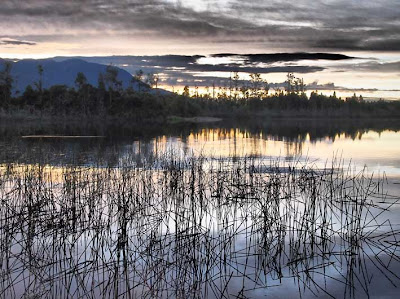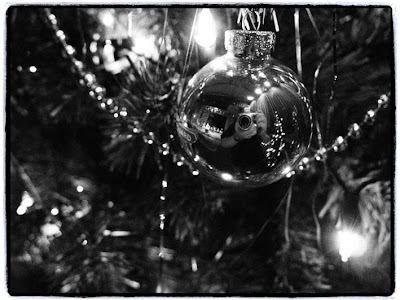Up until a couple of nights ago, I'd really only use the Pen Ep-3 as a family, snap-shot camera. My 'carry around for fun' compact camera. And it's great for such a purpose. But is that all it's good for? Or can I start using it as my really 'serious' camera for professional work?
 |
| Te Kinga Sunset. Olympus EP-3, Dramatic Tone filter |
Just before the new year, a friend invited me to go out with him to shoot the sunset. We had been having amazing sunsets, night after night, so I jumped at the chance to go out with him - even though this particular night didn't look that promising.
We headed out to Moana, a town about half an hours travel from Greymouth, that has stunning lake views if the light is right (and we were hoping it would be).
Sunset was late - around 9.30pm, so we travelled around a bit in the early evening, looking to find the right spot to set up and catch the sunset. We finally settled on the tiny settlement of Te Kinga, nestled next to the lake (Lake Brunner), since it offered a range of possibilities for varied shots.
The above image was taken reasonably early on in the evening, around 8.00pm, just as the sun was starting to sink and colour was appearing on the horizon. As soon as we saw this happen, we knew we were going to be lucky enough to witness another stunning sunset - and even more lucky to catch it on camera!
 |
| Pink Sky's at Night. Olympus EP-3, Pop Art filter |
At the beginning of the evening I set the camera to the
'Dramatic Tone' filter, hoping that it would really amp up the drama and the colours appearing in the sky. The results were ok, but not really what I was after.
Then I switched to the
'Pop Art' filter, and bingo - success! The colours that were already happening in the sky were intensified 100%, and immediately I knew this was what I was after.
The
Pop Art filter has two saturation settings - the first is totally crazy psychedelic, the second a bit more subtle, and it was the second setting that I went for. Enough to make you go 'wow', but not too much to make you go 'aarrghh'.
Funnily enough, the
Pop Art filter was one of the filter sets I dismissed as pointless when I initially looked through the menu, but in reality I've started using it quite a bit. And for sunsets, it rocks!
 |
| Te Kinga Silhouette. Olympus EP-3, Pop Art filter |
Shooting in Art Filter mode allowed me to keep the ISO on 'Auto' and have the camera range from between 200 to 1600 (my specified limits). This, combined with a very good image stabilisation system, allowed me to hand hold the camera for all of these images. Using the attached electronic viewfinder also helps keep things steady with a point of contact when the camera is up to your eye. I was walking from one location to the next when I looked up and saw these two mighty trees silhouetted against the sunset. I 'grabbed' this shot, and moved on to the next location. This 'grab' shot - a single frame - turned out to be one of my favorite shots of the evening.
 |
| In the Fiery Glow. Olympus EP-3, Pop Art filter set to mode II |
Almost no matter where we pointed our cameras, the view, and the light, was stunning! And even though I was using the slightly more subtle mode of the Pap Art filter, occasionally the colours still over saturated. I have toned down the saturation in the above image (believe it or not) by dialing in -10 saturation in photoshop. I still love the full-on colour, but the yellow was getting a bit too 'hot' straight out of the camera, even for me.
Could I have gotten the same result by switching the colour mode on the camera to 'Vivid' (instead on Neutral)? I don't know, because I didn't try it. I suspect even at 'Vivid', the colours wouldn't be as vibrant as they are when you use the Pop Art filter - but I'll actually have to test that out next time. In fact, for a guy who likes punchy colours (Velvia is my all-time favorite film), what am I doing shooting in 'Nuetral' colour space anyway? Maybe I really should investigate further!?
 |
| Te Kinga by Moonlight. EP-3, Pop Art filter, 20sec exposure at f11 |
Anyway, I digress. Getting back to the evening... as the sun went down almost completely, the moon made an appearance and it was time to break out the tripods.
I love long exposure images, so I was very keen to see how the EP-3 handled under these conditions. To get the best out of the sensor I switched to ISO 200, to keep the noise as low as possible. But I stayed on 'Pop Art' to keep the intensity in the colours that I was seeing on the lcd screen. With an aperture of f11 to get good depth of field, shutter speeds ranged between 15 to 30 seconds, depending on where I pointed the camera. After the exposure, the camera also applied its own noise reduction process, doubling the exposure time (a 15 second exposure was followed by a 15 second noise-reduction exposure by the camera).
The resulting images are OK - but not completely noise free. To get the above image looking how I wanted, I did have to put the image through Noise Ninja. Having said that though, it cleaned up very well, and these are all jpegs remember. I probably could have gotten an even better result had I switched to RAW? That's an experiment for next time as well.
So what's the verdict? Would I use the Pen EP-3 for 'serious' professional landscape work? Yes, I would. In fact I'm sure that some of these Te Kinga sunset images will appear in future calendars. I wouldn't hesitate to print them up to 8x12 as is - and easily 11x16 with some added noise reduction.
Has it made my Canon gear obsolete? No, of course not. If anything, the limiting factor for me at the moment is lenses. 28mm isn't quite wide enough for me at time on the EP-3. I'd love to go to 24mm, or maybe even 20mm.
Hang on... isn't there a conversion lens that lets you do that to the standard lens on the Pen? Might have to look into that I reckon.












